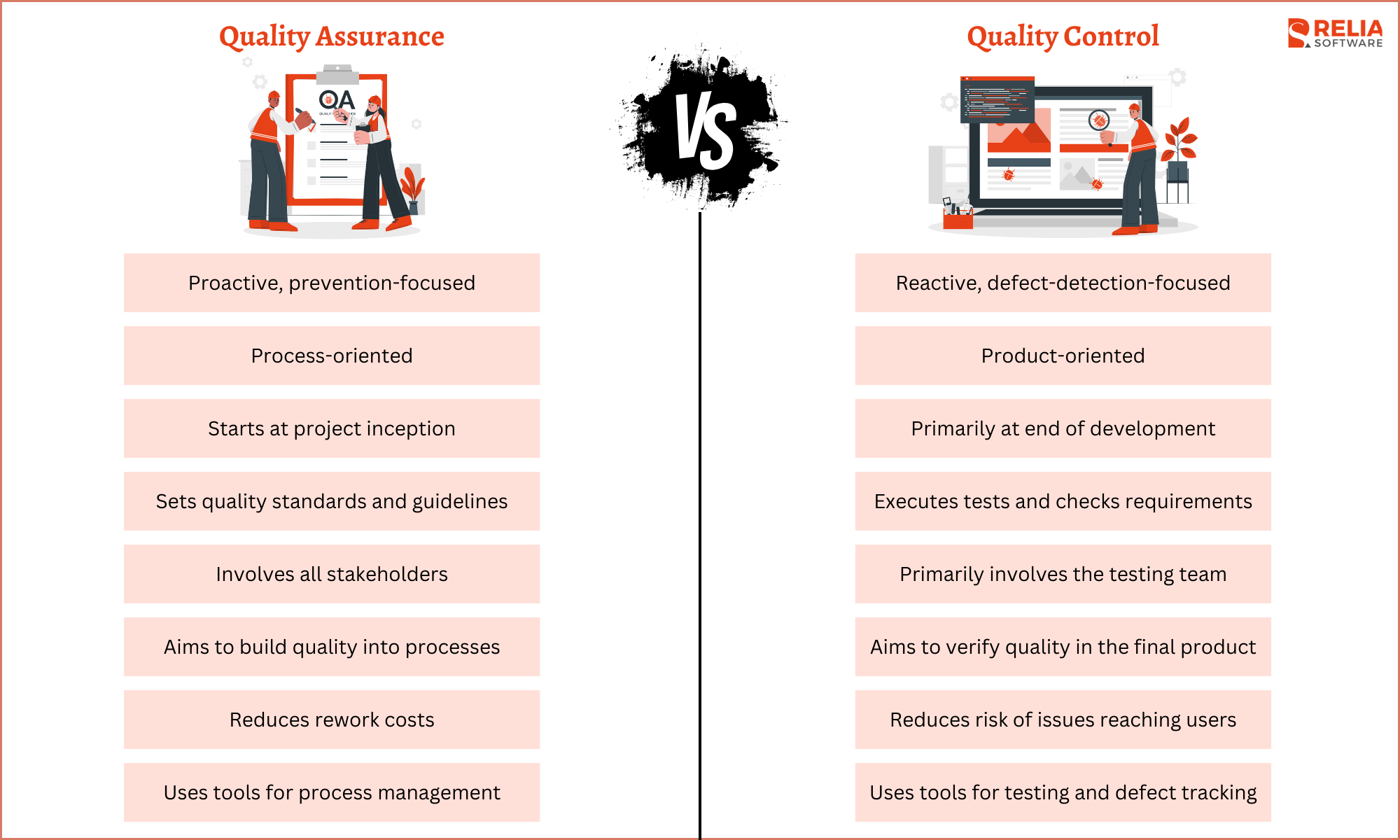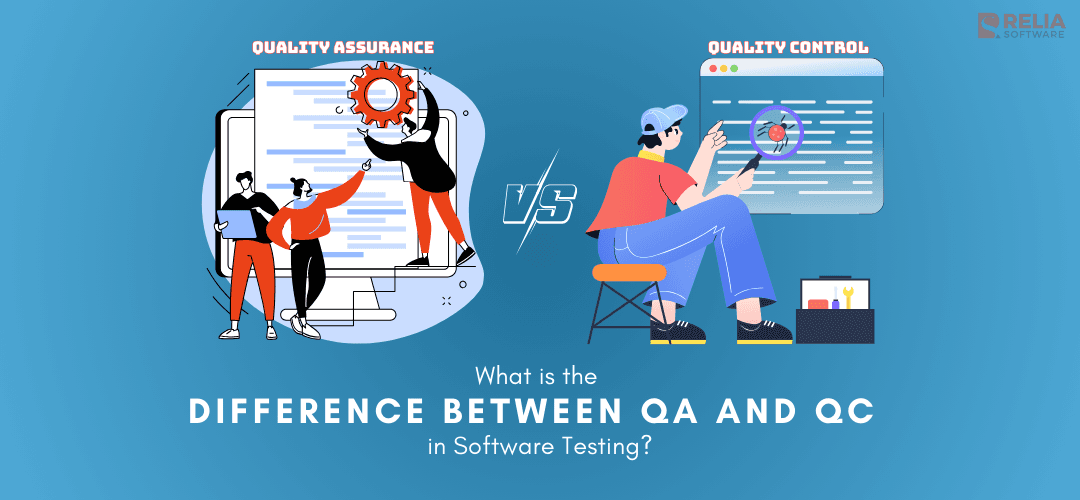In software development, quality isn’t just about finding and fixing bugs—it’s about building strong processes to prevent issues and meet user expectations. Quality Assurance (QA) and Quality Control (QC) thus become helpful. While often confused, QA and QC have their own roles: QA creates a process to prevent problems, while QC catches and fixes issues in the final product.
In this article, I’ll explain the difference between QA and QC, how they help create quality software, and how they work together to keep users happy.
What is QA (Quality Assurance)?
Quality Assurance (QA) is a proactive approach to prevent defects from being introduced during the software development lifecycle. It sets up processes, standards, and guidelines that the whole team understands and follows from the beginning, keeping everything on track.
QA teams start working on a project early on and stay engaged throughout development. They work closely with developers to review requirements, design documents, and code. They also assess risks and do early checks to catch issues before they become bigger problems.

What is QC (Quality Control)?
Quality Control (QC) is a reactive approach used to find and fix bugs that might not have been caught during development. QC tests the software to ensure it works as expected and is defects-free.
QC teams usually step in once development is complete, running test cases, analyzing results, and reporting any issues back to the developers for fixing. They may also run regression tests to make sure new changes don’t cause new issues.

Key Differences Between QA and QC in Software Testing
Before diving into the details, this table quickly highlights the main differences between QA and QC:
| Aspect | Quality Assurance (QA) | Quality Control (QC) |
| Objective | Prevent defects | Find and fix defects |
| Approach | Proactive (verification) | Reactive (validation) |
| Focus | Process improvement | Product testing |
| Timing | Throughout SDLC | After development (STLC) |
| Team Involvement | Various stakeholders (Project managers, developers, product owner, etc.) | Testing team, sometimes end-users in acceptance testing. |
| Tasks | Sets standards, reviews requirements, audits processes, risk assessment | Executes test cases, analyzes results, reports and retests defects |
| Time Usage | Ongoing, mainly early stages | Primarily near project end |
| Tools | Process and code quality tools (e.g., Jira, SonarQube) | Testing and defect tracking tools (e.g., Selenium, Postman, Bugzilla) |
| Metrics | Process efficiency, defect prevention rate, adherence to standards. | Defect density, test coverage, defect resolution time. |
Objective
- QA: Prevent defects from arising by building quality into every stage of the development process. Getting rid of problems early on saves a lot of money on fixes later on.
- QC: Find and fix any defects in the final product. It makes sure that the software meets specified requirements, which means it's ready for users.
Approach
- QA: QA is a proactive approach that works to prevent issues before they happen. Instead of waiting for problems, QA sets high standards from the start and verifies each stage meets quality standards.
- QC: QC is a reactive approach that identifies and fixes any defects or gaps that may unexpectedly happen during the process. It validates that the final product meets all requirements, leaving no issues unresolved.
>> Read more: Difference between Verification and Validation in Software Testing
Focus
- QA: QA focuses on processes, improving how things are done at each stage of development. Its goal is to set up strong quality practices from the start, making sure each step follows set standards.
- QC: QC focuses on the final product, testing the software to check if it meets the required standards. Through testing, QC makes sure the product is what users expect and need.
Timing
- QA: QA starts right from the beginning of the Software Development Life Cycle (SDLC) and stays with the project through all of its stages—planning, design, development, and release.
- QC: QC takes place mainly in the Software Testing Life Cycle (STLC), after development is finished. It serves as a final check before release to help the product meet quality standards.
Team Involvement
- QA: QA brings together various stakeholders like project managers, developers, and product owners to set and maintain quality standards throughout the development process. Their main focus is to ensure that processes align to deliver consistent quality.
- QC: QC primarily involves the testing team, who are responsible for testing and validating the product. Additionally, end-user feedback may also be included during acceptance testing to confirm that the product meets their expectations.
Tasks
QA Team:
- Set up processes and standards for quality.
- Conduct regular audits to ensure quality standards are being followed.
- Review requirements and evaluate design documents.
- Perform risk analyses to identify potential issues early.
- Collaborate with developers to maintain quality from the beginning of the development cycle.
QC Team:
- Run test cases on the finished product to make sure it works.
- Analyze test results and track identified defects.
- Conduct regression and functional testing to verify performance and reliability.
- Report bugs to the development team for fixing.
- Re-test fixes to ensure they don't cause any new problems.
Time Consumption
- QA: QA requires time investment throughout the project, but it's most important in the beginning when quality standards and procedures are set. QA cuts down on problems and extra work later in the cycle, but it takes ongoing work.
- QC: QC usually requires time at the end of the development process, focusing on testing the final product. The amount of time needed depends on how complicated the product is and how many bugs there are in it.
Type of Tools
- QA Tools: QA tools support process management, documentation, and static analysis. Common tools include Jira (for tracking), Confluence (for documentation), and SonarQube (for code quality). These tools help the team set and monitor quality practices. Besides, teams should also consider SonarQube competitors to have more suitable options.
- QC Tools: QC tools are used for testing and tracking defects. Popular tools are Selenium (for automation tests), Postman (for API testing), and Bugzilla (for defect tracking). These tools help QC teams make sure the product works and is of good quality.
>> You may be interested in:
- Top 6 Automation Testing Tools for Businesses in 2024
- Top 7 Web App Security Testing Tools For Developers
- Top 7 Best Performance Testing Tools for Developers
Measurement and Metrics
- QA: QA metrics might include process efficiency, adherence to standards, and defect prevention rates. These metrics focus on the effectiveness of processes.
- QC: QC metrics are often related to the product, such as defect density, test coverage, and time to resolve defects. These metrics assess product readiness and quality before release.

How QA and QC Work Together?
QA and QC can complement each other's roles:
- QA and QC work together to create a strong quality plan. QA sets the foundation by building quality into processes from the start to prevent issues before they occur. QC then steps in to test the final product, identifying and fixing any missed defects to provide an extra layer of assurance.
- QC provides helpful feedback to QA to improve future work. When QC finds repeating issues or common mistakes, QA can update standards, change guidelines, or improve processes to prevent these problems from happening again. This feedback loop between QA and QC supports ongoing improvement, helping teams improve the process and the product over time.
FAQs
Are QA and QC interchangeable?
No, QA and QC are not interchangeable. QA is focused on preventing defects by setting up quality processes from the start, while QC tests the final product to catch and fix any remaining issues. QA ensures quality through proactive planning, whereas QC provides a final check through testing and validation.
What are the cost impacts of prioritizing QA over QC in a development project?
Prioritizing QA can lower long-term costs by reducing rework and defects early in the process. It minimizes expensive last-minute fixes in QC, leading to more efficient resource use and cost savings over time.
What types of projects might require a heavier focus on QA compared to QC, or vice versa?
Projects that are complex or have strict regulations usually need more QA to prevent issues early. On the other hand, smaller projects or prototypes might focus more on QC to test functionality without needing extensive process control.
>> Read more testing-related topics:
- Detailed Explanation of 7 Software Testing Principles
- 4 Levels Of Testing In Software Testing: Explanation & Examples
- How to Write A Powerful Test Plan in Software Testing?
- Manual Testing vs Automation Testing: Which is Better?
Conclusion
QA and QC are both important for creating high-quality software, but they focus on different parts of the process. QA is proactive, building quality into each step of development to prevent issues early on. QC is reactive, finding and fixing any leftover issues in the final product. Together, they create a balanced approach: QA helps reduce defects from the start, and QC makes sure the product is user-ready.
Using both QA and QC allows teams to work more effectively, cut costs, and deliver reliable software. Understanding how these two roles support each other helps teams make better choices, improve quality throughout development, and consistently meet user expectations.
>>> Follow and Contact Relia Software for more information!
- testing
- development

